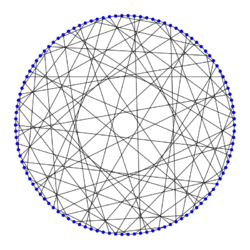110-vertex Iofinova-Ivanov graph
| 110-vertex Iofinova-Ivanov graph | |
|---|---|
 | |
| Vertices | 110 |
| Edges | 165 |
| Radius | 7 |
| Diameter | 7 |
| Girth | 10 |
| Automorphisms | 1320 (PGL2(11)) |
| Chromatic number | 2 |
| Chromatic index | 3 |
| Properties | semi-symmetric bipartite cubic Hamiltonian |
| Table of graphs and parameters | |
The 110-vertex Iofinova-Ivanov graph is, in graph theory, a semi-symmetric cubic graph with 110 vertices and 165 edges.
Properties
Iofinova and Ivanov proved in 1985 the existence of five and only five semi-symmetric cubic bipartite graphs whose automorphism groups act primitively on each partition.[1] The smallest has 110 vertices. The others have 126, 182, 506 and 990.[2] The 126-vertex Iofinova-Ivanov graph is also known as the Tutte 12-cage.
The diameter of the 110-vertex Iofinova-Ivanov graph, the greatest distance between any pair of vertices, is 7. Its radius is likewise 7. Its girth is 10.
It is 3-connected and 3-edge-connected: to make it disconnected at least three edges, or at least three vertices, must be removed.
Coloring
The chromatic number of the 110-vertex Iofina-Ivanov graph is 2: its vertices can be 2-colored so that no two vertices of the same color are joined by an edge. Its chromatic index is 3: its edges can be 3-colored so that no two edges of the same color met at a vertex.
Algebraic properties
The characteristic polynomial of the 110-vertex Iofina-Ivanov graph is [math]\displaystyle{ (x-3) x^{20} (x+3) (x^4-8 x^2+11)^{12} (x^4-6 x^2+6)^{10} }[/math]. The symmetry group of the 110-vertex Iofina-Ivanov is the projective linear group PGL2(11), with 1320 elements.[3]
Semi-symmetry
Few graphs show semi-symmetry: most edge-transitive graphs are also vertex-transitive. The smallest semi-symmetric graph is the Folkman graph, with 20 vertices, which is 4-regular. The three smallest cubic semi-symmetric graphs are the Gray graph, with 54 vertices, this the smallest of the Iofina-Ivanov graphs with 110, and the Ljubljana graph with 112.[4][5] It is only for the five Iofina-Ivanov graphs that the symmetry group acts primitively on each partition of the vertices.
References
- ↑ Han and Lu. "Affine primitive groups and Semisymmetric graphs". http://www.combinatorics.org/ojs/index.php/eljc/article/viewFile/v20i2p39/pdf. Retrieved 12 August 2015.
- ↑ Weisstein, Eric. "Iofinova-Ivanov Graphs". Wolfram. http://mathworld.wolfram.com/Iofinova-IvanovGraphs.html. Retrieved 11 August 2015.
- ↑ Iofinova and Ivanov (2013). Investigations in Algebraic Theory of Combinatorial Objects. Springer. p. 470. ISBN 9789401719728. https://books.google.com/books?id=NVDqCAAAQBAJ&q=Iofinova+graph&pg=PA470. Retrieved 12 August 2015.
- ↑ Conder, M.; Malnič, A. (2002), "The Ljubljana Graph", IMFM Preprints (Ljubljana: Institute of Mathematics, Physics and Mechanics) 40 (845), http://www.imfm.si/preprinti/PDF/00845.pdf
- ↑ "A census of semisymmetric cubic graphs on up to 768 vertices", Journal of Algebraic Combinatorics 23 (3): 255–294, 2006, doi:10.1007/s10801-006-7397-3.
Bibliography
- Iofinova, M. E. and Ivanov, A. A. Bi-Primitive Cubic Graphs. In Investigations in the Algebraic Theory of Combinatorial Objects. pp. 123–134, 2002. (Vsesoyuz. Nauchno-Issled. Inst. Sistem. Issled., Moscow, pp. 137–152, 1985.)
- Ivanov, A. A. Computation of Lengths of Orbits of a Subgroup in a Transitive Permutation Group. In Methods for Complex System Studies. Moscow: VNIISI, pp. 3–7, 1983.
- Ivanov, A. V. On Edge But Not Vertex Transitive Regular Graphs. In Combinatorial Design Theory (Ed. C. J. Colbourn and R. Mathon). Amsterdam, Netherlands: North-Holland, pp. 273–285, 1987.

